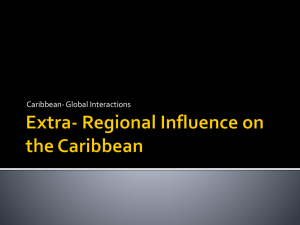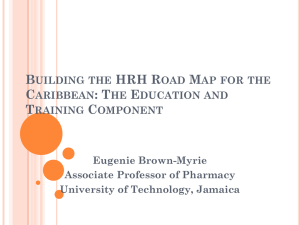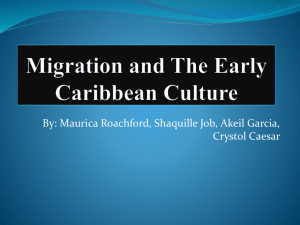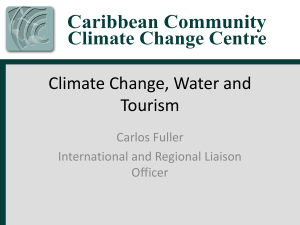Caribbean Community
advertisement
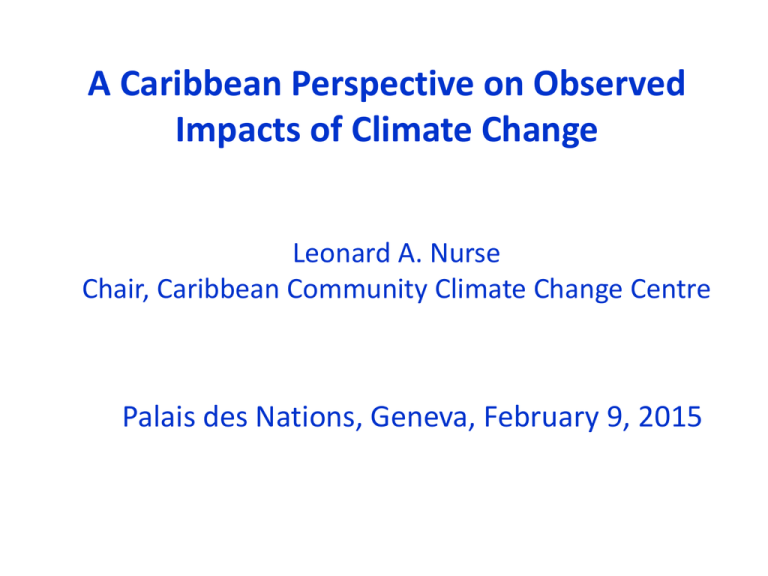
A Caribbean Perspective on Observed Impacts of Climate Change Leonard A. Nurse Chair, Caribbean Community Climate Change Centre Palais des Nations, Geneva, February 9, 2015 Observed Temperature Changes in the Caribbean Reflect Global Trends Source: Peterson et al, 2002. Slide courtesy Dept. Physics, UWI, Mona, Jamaica Observed Rainfall Changes • Mean annual rainfall over Caribbean, 1900-2000 → a consistent decline by around 0.18 mm yr -1 • Southern Caribbean region → contraction in ‘traditional’ wet season (June-Oct), 1900-1980 • Longer dry spells and increasing drought incidence since 1900 • Saint Lucia suffered its worst • Increase in number of drought in 40 years in 2009-2010 heavy rainfall events in • Hurricane Tomas in Saint Lucia in last 75 years 2010 produced 25” of rainfall in some areas in 24 hours 20th Century Observed SLR in SIDS Regions ◘ Tropical Western Pacific → rate of rise is almost 4 times the global average. ◘ Indian Ocean → rate of SLR as much as twice global average ◘ In Caribbean → rate of SLR generally higher than global average, ~ 1.8mm yr-1. ◙ Guyana → observed mean rate of rise ~ 2.4 mm yr-1. Impact on Freshwater Supply MAJOR CHALLENGE FOR WATER RESOURCE MANAGERS Declining mean annual rainfall + More frequent, longer dry spells + Higher evaporation rates + Salinity intrusion + Present (and future) demand Coral Reefs – High Value Ecosystems At Serious Risk • Causal link between ocean warming & coral bleaching → major events in C’bean (e.g. ’83; ’97/’98; 2005/2006; 2009/2010) → SSTs ≥ 10 C above seasonal maximum. • Many studies show that C’bean reefs will continue to be severely degraded in coming decades, based on response of corals to thermal stress. • No field evidence that corals can evolve & adapt to unabated thermal stress on decadal timescales. • As global studies show – what we se in our region corroborates some global findings…Research in C’bean suggests that global mean 0T would need to be limited to ≈1.2 °C rel. to Preindustrial, to save 50% of corals. Source: Mumby et al, 2014: Towards Reef Resilience and Sustainable Livelihoods: A Handbook for Caribbean Coral Reef Managers. University of Queensland Press, Brisbane, Australia, 172 pp. ISBN 978-0-902746-31-2 • As oceans continue to acidify with a predicted further fall in pH of 0.1 – 0.4 by the end of century (IPCC 2013) → impacts will be significant. SSA • Aragonite is mineral form of CaCO3 found in corals & some other marine organisms . • The lower the aragonite saturation state of H2O → more difficult for corals to produce skeletons. • 1988-2012 data for Caribbean → decreases in ocean pH reflected in sustained decrease in aragonite saturation. Caribbean aragonite saturation state, 1988-2012 (Mumby et al, 2014) Observed Impacts on Human Health • Higher incidence of some vectorborne diseases since 1970, e.g. dengue fever → climate-sensitive vector & transmission factors • Increased morbidity & mortality from hydro-meteorological events since 1950 - flood, storms • Since 1960, Increasing freshwater scarcity – sanitation & hygiene • Higher incidence of ciguatera fish poisoning in last 4 decades → higher SST provide favourable conditions for ciguatoxins Impacts on Tourism Atlantis Hotel, The Bahamas Nassau Airport, The Bahamas, 2005 • Direct & indirect effects from climate change ◙ Increased risk to critical infrastructure → air & seaports, accommodations ◙ Sea level rise amplifies ocean swell & storm surge elevations → flooding, accelerated coastal erosion and land loss ◙ Loss of climate-sensitive attractions, e.g. corals → considerable revenues from scuba diving etc. • Bonaire earns > USD 50 M/yr from recreational diver fees (Univ. of Amsterdam, 2013). • Belize earned between USD 150 M-196 M from ‘coral reef and mangrove-related recreation’ in 2007 (NOAA, 2005) 10 C – 40 C Warming (relative to 1960-1990 mean) Projected by End of Century A2 B2 Model Runs based on: HADCM3 (GCM) ECHAM4 (GCM) PRECIS (RCM) Results: 25-30% decrease in rainfall before end of century Drying trend between -25% and -30 % by end of Century. Drying far exceeds natural variability. Drier wet season likely (Taylor, 2011) Drying exceeds natural variability June-October –wet season dryer ! CARIBBEAN CONTRIBUTION TO ACHIEVEMENT OF THE LONG-TERM GLOBAL GOAL Caribbean Community - Strategic Programme and Plan of Implementation • CARICOM Heads mandated the CCCCC to develop “Regional Framework for Achieving Development Resilient to Climate Change” and “Implementation Plan” • The Heads approved the Strategy in July 2009 • Framework and Plan focus on key strategic elements, including: ◙ Economic trends and challenges ◙ Social sector trends and challenges ◙ Technology trends and challenges ◙ ‘Energy for sustainable development’ Caribbean Community Energy Policy, 2013 “GOAL/VISION: Fundamental transformation of the energy sectors of the Member States of the Community through the provision of secure and sustainable supplies of energy in a manner which minimizes energy waste in all sectors, to ensure that all CARICOM citizens have access to modern, clean and reliable energy supplies at affordable and stable prices, and to facilitate the growth of internationally competitive Regional industries towards achieving sustainable development of the Community.” • January 26, 2015 → co-hosted by US Dept. of State, Council of the Americas and the Atlantic Council ◙ 26 countries including CARICOM states commit to “clean sustainable energy for all”. ◙ 7 Regional and International Agencies: CARICOM, CDB, EU, IDB, IRENA, OAS and WB. ◙ WB → Caribbean Energy Investment network. ◙ US Overseas Private Investment Corporation → clean energy program in Caribbean, including USD 43 M for 34 MW wind energy project in Jamaica. SIDS DOCK – Sustainable Energy Initiative for Small Island Developing States The initiative was conceived and developed by the Caribbean Community Climate Change Centre (CCCCC) and the South Pacific Regional Environment Programme (SPERP). The goals are to: ◙ Increase energy efficiency by 25 percent (2005 baseline) ◙ Generate a minimum of 50 percent of electric power from renewable sources by 2033 ◙ Achieve a 20-30 percent decrease in the use of conventional transportation fuel in SIDS by 2033. • Partnership established by MOU with the Alliance of Small Island States (AOSIS), UNDP, World Bank and the Gov’t of Denmark. •Launched in December 2010 in Cancun, Mexico, with USD 14. 5 million grant from the Government of Denmark. •Twenty-six (26) SIDS have responded to the Initiative Wigton Wind Farm, Manchester, Jamaica Photo credit: jamaica-gleaner.com • Operational from 2004 • Current installed capacity → 38.7 MW • Jamaica’s fuel import bill reduced by > USD 2.5 M/yr. • Annual emissions avoided → 40,000 tCO2e • Provides electricity for > 24,000 homes • Registered as CDM Project March 2006 Jamaica: Deployment of RE & Energy Efficiency in Public Sector • Objective: To advance a low carbon development path and reduce Jamaica’s public sector energy bill through the introduction of RE and EE in the health sector • Economic & fiscal instruments for uptake of RE and EE technologies in public sector • Investment packages for scale up of RE and EE → solar water heating, photovoltaics, energy efficient air conditioning & lighting installations & retrofits • 1 MW worth of installations in the Jamaican health sector targeting 10-15 hospitals • Projected GHG emission reduction → 348,995 tCO2e Sustainable Energy for the Eastern Caribbean (SEEC): Antigua & Barbuda, Grenada, St. Vincent & the Grenadines • Objectives: (i) Reduce dependency on fossil fuels by promoting EE measures & RE solutions (ii) Promote access to finance for RE for domestic and commercial installations (iii) Reduce energy consumption & costs (iv) Increase competitiveness of participating states (v) Reduction in GHG emissions. ◙ ‘Smart Grid’ solutions ◙ Minimum of 1.5 MW of new grid-connected RE projects installed in the 3 countries (mainly PV capacity) in public & private sectors. ◙ Minimum of 1.5 MW of new solar thermal water heating capacity installed in the participating countries. ◙ Projected direct & indirect GHG emissions reduction → 480,000 tCO2e. Sustainable Energy Program for Guyana • Objectives: (i) Improve institutional capacity of Guyana Power and Light & Office of the Prime Minister → training & promotion of non-conventional RETs in urban areas and hinterland (ii) Strengthen capacity of GPL to supply and integrate RE into its grid (iii) Promote use of RETs and reduce national GHG emissions. ◙ Portfolio of solar-PV rural electrification projects already implemented in Amerindian communities → 1,112 kW of solar-PV for rural electrification and 180 kW on-grid solar-PV ◙ 2 hydropower stations already constructed and are operating efficiently → 2,000 kW & 300 kW ◙ 300 kW of wind power being generated. ◙ Projected GHG emissions reduction of 330,759 tCO2e over 20 years Summary Perspective • Climate change will continue to exacerbate existing challenges, as well as trigger new ones. • Caribbean believes that there is adequate, credible evidence to justify pursuit of long-term goal that limits global 0T to under < 2 0C relative to Pre-Industrial mean • Delaying ‘aggressive’ mitigation will: ◙ frustrate achievement of long-term goal ◙ impose further limits on adaptation • Caribbean region has demonstrated a clear commitment to achievement of long-term goal





